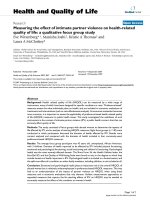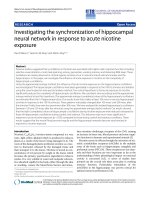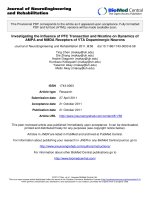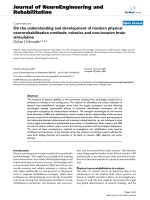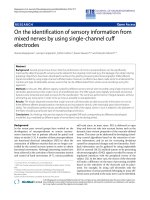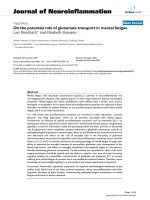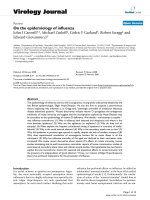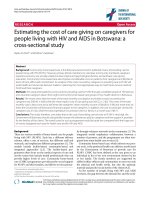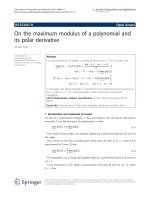Báo cáo hóa học: " On the stability of an AQCQ-functional equation in random normed spaces" potx
Bạn đang xem bản rút gọn của tài liệu. Xem và tải ngay bản đầy đủ của tài liệu tại đây (298.37 KB, 12 trang )
RESEARCH Open Access
On the stability of an AQCQ-functional equation
in random normed spaces
Choonkil Park
1
, Sun Young Jang
2
, Jung Rye Lee
3
and Dong Yun Shin
4*
* Correspondence:
kr
4
Department of Mathematics,
University of Seoul, Seoul 130-743,
Republic of Korea
Full list of author information is
available at the end of the article
Abstract
In this paper, we prove the Hyers-Ulam stability of the following additive-quadratic-
cubic-quartic functional equation
f (x +2y)+f (x − 2y)=4f (x + y)+4f (x − y) − 6f (x)
+ f
(
2y
)
+ f
(
−2y
)
− 4f
(
y
)
− 4f
(
−y
)
in random normed spaces.
2010 Mathematics Subject Classification: 46S40; 39B52; 54E70
Keywords: random normed space, additive-quadratic-cubic-quartic functional equa-
tion, Hyers-Ulam stability
1. Introduction
The stability problem of functional equations originated from a question of Ulam [1] in
1940, concerning the stability of group homomorphisms. Let (G
1
,·)beagroupandlet
(G
2
,*,d) be a metric group with the metric d(· , ·). Given ε > 0, does there exist a δ >
0 such that if a mapping h : G
1
® G
2
satisfies the inequality d(h(x·y), h(x)*h(y)) < δ
for all x, y Î G
1
, then there exists a homomorphism H : G
1
® G
2
with d(h(x), H(x)) <
ε for all x Î G
1
? In the other words, under what condition does there exists a homo-
morphism near an approximate homomorphism? The concept of stability for func-
tional equatio n arise s when we replace the functional equation by an inequality which
acts as a perturbation of the equation. Hyers [2] gave a first affirmative answer to the
question of Ulam for Banach spaces. Let f : E ® E’ be a mapping between Banach
spaces such that
f
(
x + y
)
− f
(
x
)
− f
(
y
)
≤
δ
for all x, y Î E and some δ > 0. Then, there exists a unique additive mapping T : E
® E ’ such that
||f
(
x
)
− T
(
x
)
|| ≤
δ
for all x Î E. Moreover, if f(tx) is continuous in t Î ℝ for each fixed x Î E, then T is
ℝ-linear. In 1978, Th.M. Rassias [3] provided a generalization of the Hyers’ theorem
that allows the Cauchy difference to be unbounded. In 1991, Ga jda [4] answered the
question for the case p > 1, which was raised by Th.M. Rassias (see [5-11]).
Park et al. Journal of Inequalities and Applications 2011, 2011:34
/>© 2011 Park et al; licensee Springer. This is an Open Access article distributed under the terms of the Creative Commons Attribution
License ( which permits unrestricted use, distribution, and reproduction in any mediu m,
provided the original work is properly ci ted.
On the other hand, in 1982-1998, J.M. Rassias gene ralized the Hyers ’ sta bility result
by presenting a weaker condition controlled by a product of different powers of norms.
Theorem 1.1. ([12-18]). Assume that there exist constants Θ ≥ 0 and p
1
, p
2
Î ℝ such
that p = p
1
+ p
2
≠ 1, and f : E ® E’ is a m apping from a normed space E into a
Banach space E’ such that the inequality
|
|f
(
x + y
)
− f
(
x
)
− f
(
y
)
|| ≤ ε||x||
p
1
||y||
p
2
for all x, y Î E. Then, there exists a unique additive mapping T : E ® E’ such that
|
|f (x) − L(x)|| ≤
2
−
2
p
||x||
p
for all × Î E.
The control function ||x||
p
·||y||
q
+||x||
p+q
+||y||
p+q
was introduced by Rassias [19]
and was used in several papers (see [20-25]).
The functional equation
f
(
x + y
)
+ f
(
x − y
)
=2f
(
x
)
+2f
(
y
)
(1:1)
is related to a symmetric bi-additive mapping. It is natural that this equation is called
a quadratic functional equation. In particular, every solution of the quadratic functional
equation (1.1) is said to be a quadratic mapping. It is well known that a mapping f
between real vector spaces is quadratic if and only if there exists a unique symmetric
bi-additive mapping B such that f(x)=B(x, x)forallx (see [5,26]). The bi-additive
mapping B is given by
B(x, y)=
1
4
(f (x + y) − f(x − y))
.
The Hyers-Ulam stability problem for the quadratic functional equation (1.1) was
proved by Skof for map pings f : A ® B,whereA is a normed space and B is a Banach
space (see [27]). Cholewa [28] noticed that the theorem of Skof is still true if relevant
domain A is replaced by an abelia n group. In [29], Czerwik proved the Hyers-Ulam
stability of the functional equation (1.1). Grabiec [30] has generalized these results
mentioned above.
In [31], Jun and Kim considered the following cubic functional equation:
f
(
2x + y
)
+ f
(
2x − y
)
=2f
(
x + y
)
+2f
(
x − y
)
+12f
(
x
).
(1:2)
It is easy to show that the function f(x)=x
3
satisfies the functional equation (1.2),
which is called a cubic functional equation and every solution of the cubic functional
equation is said to be a cubic mapping.
In [32], Park and Bae considered the following quartic functional equation
f
(
x +2y
)
+ f
(
x − 2y
)
=4[f
(
x + y
)
+ f
(
x − y
)
+6f
(
y
)
] − 6f
(
x
).
(1:3)
Infact,theyprovedthatamappingf between two real vector spaces X and Y is a
solution of (1:3) if and only if there exists a unique symmetric multi-additive mapping
M : X
4
® Y such that f(x)=M(x, x, x, x) for all x. It is easy to show that the function
f(x)=x
4
satisfies the functional equation (1.3), which is called a quartic functional
equation (see also [33]). In addition, Kim [34] has obtained the Hyers-Ulam stability
for a mixed type of quartic and quadratic functional equation.
Park et al. Journal of Inequalities and Applications 2011, 2011:34
/>Page 2 of 12
It should be noticed that in all these papers, the triangle inequality is expressed by
using the strongest triangular norm T
M
.
The aim of this paper is to i nvestigate the Hyers-Ulam stability of the additive-quad-
ratic-cubic-quartic functional equation
f (x +2y)+f (x − 2y)=4f (x + y)+4f(x − y) − 6f(x)
+ f
(
2y
)
+ f
(
−2y
)
− 4f
(
y
)
− 4f
(
−y
)
(1:4)
in random normed spaces in the sense of Sherstnev under arbitrary continuous t-
norms.
In the sequel, we adopt the usual terminology, notations and conventions of the the-
ory of random normed spaces, as in [35-37]. Throughout this paper, Δ
+
is the space of
distribu tion functions, that is, the space of all mappings F : ℝ ∪ {-∞, ∞} ® [0, 1] such
that F is left-continuou s and non-decreasing on ℝ, F(0) = 0 and F(+ ∞)=1.D
+
is a
subset of Δ
+
consisting of all functions F Î Δ
+
for which l
-
F(+ ∞)=1,wherel
-
f (x)
denotes the left limit of the function f at the point x,thatis,
l
−
f
(
x
)
= lim
t
→x
−
f
(
t
)
.The
space Δ
+
is partially ordered by the usual point-wise ordering of functions, i.e., F ≤ G
if and only if F(t) ≤ G(t) for all t in ℝ. The maximal element for Δ
+
in this order is the
distribution function ε
0
given by
ε
0
(t )=
0, if t ≤ 0,
1, if t > 0
.
Definition 1.2. [36]A mapping T : [0, 1] × [0, 1] ® [0, 1] is a continuous triangular
norm (briefly, a continuous t-norm) if T satisfies the following conditions:
(a) T is commutative and associative;
(b) T is continuous;
(c) T(a,1)=a for all a Î [0, 1];
(d) T (a, b) ≤ T(c, d) whenever a ≤ c and b ≤ d for all a, b, c, d Î [0, 1].
Typical examples of continuous t-norms are T
P
(a, b)=ab , T
M
(a, b)=min(a, b)
and T
L
(a, b) = max(a+b-1, 0) (the Lukasiewicz t-norm). Recall (see [38,39]) that if T is
a t -norm and {x
n
} is a given sequence of numbers in [0, 1], then
T
n
i
=1
x
i
is defined recur-
rently by
T
1
i
=1
x
i
= x
1
and
T
n
i
=1
x
i
= T(T
n−1
i
=1
x
i
, x
n
)
for n ≥ 2.
T
∞
i
=
n
x
i
is defined as
T
∞
i
=1
x
n+i−
1
.It
is known [39] that for the Lukasiewicz t-norm, the following implication holds:
lim
n→∞
(T
L
)
∞
i=1
x
n+i−1
=1⇔
∞
n
=1
(1 − x
n
) <
∞
Definition 1.3. [37]A random normed space (briefly, RN-spac e) is a tripl e (X, μ, T),
where × is a vector space, T is a continuous t-norm, and μ is a mapping from × into D
+
such that the following conditions hold:
(RN
1
) μ
x
(t)=ε
0
(t) for all t >0if and only if × =0;
(RN
2
)
μ
αx
(t )=μ
x
(
t
|
α
|
)
for all × Î X, a ≠ 0;
(RN
3
) μ
x+y
(t + s) ≥ T (μ
x
(t), μ
y
(s)) for all x, y Î X and all t, s ≥ 0.
Every normed space (X, ||·||) defines a random normed space (X, μ, T
M
),
where
μ
x
(t )=
t
t +
||
x
||
Park et al. Journal of Inequalities and Applications 2011, 2011:34
/>Page 3 of 12
for all t >0,andT
M
is the minimum t-norm. This space is called the induced ran-
dom normed space.
Definition 1.4. Let (X, μ, T) be an RN-space.
(1) A se quence {x
n
} in × is said to be convergent to × in × if, for every ε >0and l >
0, there exists a positive integer N such that
μ
x
n
−
x
(ε) > 1 −
λ
whenever n ≥ N.
(2) Asequence{x
n
} in × is called a Cauchy sequence if, fo r every ε >0and l >0,
there exists a positive integer N such that
μ
x
n−x
m
(ε) > 1 −
λ
whenever n ≥ m ≥ N.
(3) An RN-space (X, μ, T) is said to be complete if and only if every Cauchy sequence
in × is convergent to a point in X.
Theorem 1.5. [36]If (X, μ, T) is an RN-space and {x
n
} is a sequence such that x
n
®
x, then
lim
n→∞
μ
x
n
(t )=μ
x
(t
)
almost everywhere.
Recently, Eshaghi Gordji et al. establish the stability of cubic, quadratic and additive-
quadratic functional equations in RN-spaces (see [40-42]).
One can easily show that an odd mapping f : X ® Y satisfies (1.4) if and only if the
odd mapping f : X ® Y is an additive-cubic mapping, i.e.,
f
(
x +2y
)
+ f
(
x − 2y
)
=4f
(
x + y
)
+4f
(
x − y
)
− 6f
(
x
).
It was shown in [[43], Lemma 2.2] that g(x):=f (2x)-8f (x) and h(x):=f (2x)-2f (x)
are additive and cubic, respectively, and that
f (x)=
1
6
h(x) −
1
6
g(x
)
.
One can easily show that an even mapping f : X ® Y satisfies (1.4) if and only if the
even mapping f : X ® Y is a quadratic-quartic mapping, i.e.,
f
(
x +2y
)
+ f
(
x − 2y
)
=4f
(
x + y
)
+4f
(
x − y
)
− 6f
(
x
)
+2f
(
2y
)
− 8f
(
y
).
It was shown in [[44], Lemma 2.1] that g (x):=f (2x)-16f (x)andh (x):=f (2x)-4f
(x) are quadratic and quartic, respectively, and that
f (x)=
1
12
h(x) −
1
12
g(x
)
Lemma 1.6. Each mapping f : X ® Y satisfying (1.4) can be realized as the sum of an
additive mapping, a quadratic mapping, a cubic mapping and a quartic mapping.
This paper is organized as follows: In Section 2, we prove the Hyers-Ulam stability of
the additive-quadratic-cubic-quartic functional equation (1.4) in RN-spaces for an odd
case. In Section 3, we prove the Hyers-Ulam stability of the additive-quadratic-cubic-
quartic functional equation (1.4) in RN-spaces for an even case.
Throughout this paper, assume that X is a real vector space and that (X, μ, T)isa
complete RN-space.
2.Hyers-Ulam stability of the functional equation (1.4): an odd mapping Case
For a given mapping f : X ® Y , we define
Df (x, y):=f (x +2y)+f (x − 2y) − 4f(x + y) − 4f (x − y)+6f (x
)
− f
(
2y
)
− f
(
−2y
)
+4f
(
y
)
+4f
(
−y
)
for all x, y Î X.
In this section, we prove the Hyers-Ulam stability of the functional equation Df (x, y)
= 0 in complete RN-spaces: an odd mapping case.
Theorem 2.1. Let f : X ® Y be an odd mapping for which there is a r : X
2
® D
+
(r
(x, y) is denoted by r
x, y
) such that
μ
Df
(
x,y
)
(t ) ≥ ρ
x,y
(t
)
(2:1)
Park et al. Journal of Inequalities and Applications 2011, 2011:34
/>Page 4 of 12
for all x, y Î X and all t >0.If
lim
n
→
∞
T
∞
k=1
(T(ρ
2
k+n−1
x,2
k+n−1
x
(2
n−3
t), ρ
2
k+n
x,2
k+n−1
x
(2
n−1
t))) =
1
(2:2)
and
lim
n
→∞
ρ
2
n
x,2
n
y
(2
n
t)=
1
(2:3)
for all x, y Î Xandallt>0,then there exist a unique additive mapping A : X ® Y
and a unique cubic mapping C : X ® Y such that
μ
f (2x)−8f(x)−A(x)
(t )
≥ T
∞
k=1
T
ρ
2
k−1
x,2
k−1
x
t
8
, ρ
2
k
x,2
k−1
x
t
2
,
(2:4)
μ
f (2x)−2f(x)−C(x)
(t )
≥ T
∞
k=1
T
ρ
2
k−1
x,2
k−1
x
t
8
, ρ
2
k
x,2
k−1
x
t
2
(2:5)
for all × Î X and all t >0.
Proof. Putting x = y in (2.1), we get
μ
f
(
3y
)
−4f
(
2y
)
+5f
(
y
)
(t ) ≥ ρ
y,y
(t
)
(2:6)
for all y Î X and all t > 0. Replacing x by 2y in (2.1), we get
μ
f
(
4y
)
−4f
(
3y
)
+6f
(
2y
)
−4f
(
y
)
(t ) ≥ ρ
2y,y
(t
)
(2:7)
for all y Î X and all t > 0. It follows from (2.6) and (2.7) that
μ
f (4x)−10f (2x)+16f (x)
(t )
= μ
(4f (3x)−16f(2x)+20f(x))+(f (4x)−4f (3x)+6f(2x)−4f (x))
(t )
≥ T
μ
4f (3x)−16f (2x)+20f(x)
t
2
, μ
f (4x)−4f (3x)+6f(2x)−4f (x)
t
2
≥ T
ρ
x,x
t
8
, ρ
2x,x
t
2
(2:8)
for all x Î X and all t >0.Letg : X ® Y be a mapping defined by g(x):=f (2x)-8f
(x). Then we conclude that
μ
g(2x)−2g(x)
(t ) ≥ T
ρ
x,x
t
8
, ρ
2x,x
t
2
for all x Î X and all t > 0. Thus, we have
μ
g(2x)
2
−g(x)
(t ) ≥ T
ρ
x,x
t
4
, ρ
2x,x
(
t
)
for all x Î X and all t > 0. Hence,
μ
g(2
k+1
x)
2
k+1
−
g(2
k
x)
2
k
(t ) ≥ T( ρ
2
k
x,2
k
x
(2
k−2
t), ρ
2
k+1
x,2
k
x
(2
k
t)
)
Park et al. Journal of Inequalities and Applications 2011, 2011:34
/>Page 5 of 12
for all x Î X, all t > 0 and all k Î N: From
1 >
1
2
+
1
2
2
+ ···+
1
2
n
, it follows that
μ
g(2
n
x)
2
n
−g(x)
(t ) ≥ T
n
k=1
μ
g(2
k
x)
2
k
−
g(2
k−1
x)
2
k−1
t
2
k
≥ T
n
k=1
T
ρ
2
k−1
x,2
k−1
x
t
8
, ρ
2
k
x,2
k−1
x
t
2
(2:9)
for all x Î X and all t > 0. In order to prove the convergence of the sequence
{
g(2
n
x)
2
n
}
,
replacing x with 2
m
x in (2.9), we obtain that
μ
g(2
n+m
x)
2
n+m
−
g(2
m
x)
2
m
(t )
≥ T
n
k=1
(T(ρ
2
k+m−1
x
,
2
k+m−1
x
(2
m−3
t), ρ
2
k+m
x
,
2
k+m−1
x
(2
m−1
t)))
.
(2:10)
Since the right-hand side of the inequality (2.10) tends to 1 as m and n tend to infi-
nity, the sequence
{
g(2
n
x)
2
n
}
is a Cauchy sequence. Thus, we may define
A(x) = lim
n→∞
g(2
n
x)
2
n
for all x Î X.
Now, we show that A is an additive mapping. Replacing x and y with 2
n
x and 2
n
y in
(2.1), respectively, we get
μ
Df (2
n
x,2
n
y)
2
n
(t ) ≥ ρ
2
n
x,2
n
y
(2
n
t)
.
Taking the limit as n ® ∞,wefindthatA : X ® Y satisfies (1.4) for all x, y Î X.
Since f : X ® Y is odd, A : X ® Y i s odd. By [[43], Lemma 2.2], the mapping A : X ®
Y is additive. Letting the limit as n ® ∞ in (2.9), we get (2.4).
Next, we prove the uniqueness of the additive mapping A : X ® Y subject to (2.4).
Let us assume that there exists another additive mapping L : X ® Y which satisfies
(2.4). Since A(2
n
x)=2
n
A(x), L(2
n
x)=2
n
L(x) for all x Î X and all n Î N, from (2.4), it
follows that
μ
A(x)−L(x)
(2t)=μ
A(2
n
x)−L(2
n
x)
(2
n+
1
t)
≥ T(μ
A(2
n
x)−g(2
n
x)
(2
n
t), μ
g(2
n
x)−L(2
n
x)
(2
n
t))
≥ T(T
∞
k=1
(T(ρ
2
n+k−1
x,2
n+k−1
x
(2
n−3
t), ρ
2
n+k
x,2
n+k−1
x
(2
n−1
t)))
,
T
∞
k=1
(T(ρ
2
n+k−1
x
,
2
n+k−1
x
(2
n−3
t), ρ
2
n+k
x
,
2
n+k−1
x
(2
n−1
t)))
(2:11)
for all x Î X and all t > 0. Letting n ® ∞ in (2.11), we conclude that A = L.
Let h : X ® Y be a mapping defined by h(x):=f (2x)-2f ( x). Then, we conclude that
μ
h(2x)−8h(x)
(t ) ≥ T
ρ
x,x
t
8
, ρ
2x,x
t
2
for all x Î X and all t > 0. Thus, we have
μ
h(2x)
8
−h(x)
(t ) ≥ T(ρ
x,x
(t ), ρ
2x,x
(4t)
)
for all x Î X and all t > 0. Hence,
μ
h(2
k+1
x)
8
k+1
−
h(2
k
x)
8
k
(t ) ≥ T(ρ
2
k
x,2
k
x
(8
k
t), ρ
2
k+1
x,2
k
x
(4 · 8
k
t)
)
Park et al. Journal of Inequalities and Applications 2011, 2011:34
/>Page 6 of 12
for all x Î X, all t > 0 and all k Î N: From
1 >
1
8
+
1
8
2
+ ···+
1
8
n
, it follows that
μ
h(2
n
x)
8
n
−h(x)
(t ) ≥ T
n
k=1
μ
h(2
k
x)
8
k
−
h(2
k−1
x)
8
k−1
t
8
k
≥ T
n
k=1
T
ρ
2
k−1
x,2
k−1
x
t
8
, ρ
2
k
x,2
k−1
x
t
2
(2:12)
for all x Î X and all t > 0. In order to prove the convergence of the sequence
{
h(2
n
x)
8
n
}
,
replacing x with 2
m
x in (2.12), we obtain that
μ
h(2
n+m
x)
8
n+m
−
h(2
m
x)
8
m
(t )
≥ T
n
k=1
(T(ρ
2
k+m−1
x
,
2
k+m−1
x
(8
m−1
t), ρ
2
k+m
x
,
2
k+m−1
x
(4 · 8
m−1
t)))
.
(2:13)
Since the right-hand side of the inequality (2.13) tends to 1 as m and n tend to infi-
nity, the sequence
{
h(2
n
x)
8
n
}
is a Cauchy sequence. Thus, we may define
C(x) = lim
n→∞
h(2
n
x)
8
n
for all x Î X.
Now, we show that C is a cubic mapping. Replacing x and y with 2
n
x and 2
n
y in
(2.1), respectively, we get
μ
Df (2
n
x,2
n
y)
8
n
(t ) ≥ ρ
2
n
x,2
n
y
(8
n
t) ≥ ρ
2
n
x,2
n
y
(2
n
t)
.
Taking the limit as n ® ∞,wefindthatC : X ® Y satisfies (1.4) for all x, y Î X.
Since f : X ® Y is odd, C : X ® Y i s odd. By [[43], Lemma 2.2], the mapping C : X ®
Y is cubic. Letting the limit as n ® ∞ in (2.12), we get (2.5).
Finally, we prove the uniqueness of the cubic mapping C : X ® Y subject to (2.5).
Let us assume that there exists another cubic mapping L : X ® Y which satisfie s (2.5).
Since C(2
n
x)=8
n
C(x), L(2
n
x)=8
n
L(x)forallx Î X and all n Î N,from(2.5),itfol-
lows that
μ
C(x)−L(x)
(2t)
= μ
C(2
n
x)−L(2
n
x)
(2 · 8
n
t)
≥ T(μ
C(2
n
x)−h(2
n
x)
(8
n
t), μ
h(2
n
x)−L(2
n
x)
(8
n
t))
≥ T(T
∞
k=1
(T(ρ
2
n+k−1
x,2
n+k−1
x
(8
n−1
t), ρ
2
n+k
x,2
n+k−1
x
(4 · 8
n−1
t)))
,
T
∞
k=1
(T(ρ
2
n+k−1
x,2
n+k−1
x
(8
n−1
t), ρ
2
n+k
x,2
n+k−1
x
(4 · 8
n−1
t)))
≥ T(T
∞
k=1
(T(ρ
2
n+k−1
x,2
n+k−1
x
(2
n−3
t), ρ
2
n+k
x,2
n+k−1
x
))),
T
∞
k=1
(T(ρ
2
n+k−1
x
,
2
n+k−1
x
(2
n−3
t), ρ
2
n+k
x
,
2
n+k−1
x
(2
n−1
t)))
(2:14)
for all x Î X and all t >0.Lettingn ® ∞ in (2.14), we conclude that C = L,as
desired. □
Similarly, one can obtain the following result.
Theorem 2.2. Let f : X ® Y be an odd mapping for which there is a r : X
2
® D
+
(r
(x, y) is denoted by r
x, y
) satisfying (2.1). If
lim
n→∞
T
∞
k=1
T
ρ
x
2
k+n
,
x
2
k+n
t
8
n+2k
, ρ
x
2
k+n−1
,
x
2
k+n
4t
8
n+2k
=
1
Park et al. Journal of Inequalities and Applications 2011, 2011:34
/>Page 7 of 12
and
lim
n→∞
ρ
x
2
n
,
y
2
n
t
8
n
=
1
for all x, y Î Xandallt>0,then there exist a unique additive mapping A : X ® Y
and a unique cubic mapping C : X ® Y such that
μ
f (2x)−8f (x)−A(x)
(t ) ≥ T
∞
k=1
T
ρ
x
2
k
,
x
2
k
t
2
2k+1
, ρ
x
2
k−1
,
x
2
k
t
2
2k−1
,
μ
f (2x)−2f (x)−C(x)
(t ) ≥ T
∞
k=1
T
ρ
x
2
k
,
x
2
k
t
8
2k
, ρ
x
2
k−1
,
x
2
k
4t
8
2k
for all × Î X and all t >0.
3. Hyers-ulam stability of the functional equation (1.4): an even mapping
case
In this section, we prove the Hyers-Ulam stability of the functional equation Df(x, y)
= 0 in complete RN-spaces: an even mapping case.
Theorem 3.1. Let f : X ® Y be an even mapping for which there is a r : X
2
® D
+
(r
(x, y) is denoted by r
x, y
) satisfying f (0) = 0 and (2.1). If
lim
n
→
∞
T
∞
k=1
(T(ρ
2
k+n−1
x,2
k+n−1
x
(2 · 4
n−2
t), ρ
2
k+n
x,2
k+n−1
x
(2 · 4
n−1
t))) =
1
(3:1)
and
lim
n
→∞
ρ
2
n
x,2
n
y
(4
n
t)=
1
(3:2)
for all x, y Î X and all t >0,then there exist a unique quadratic mapping P : X ® Y
and a unique quartic mapping Q : X ® Y such that
μ
f (2x)−16f (x)−P(x)
(t )
≥ T
∞
k=1
T
ρ
2
k−1
x,2
k−1
x
t
8
, ρ
2
k
x,2
k−1
x
t
2
,
(3:3)
μ
f (2x)−4f (x)−Q(x)
(t )
≥ T
∞
k=1
T
ρ
2
k−1
x,2
k−1
x
t
8
, ρ
2
k
x,2
k−1
x
t
2
(3:4)
for all × Î X and all t >0.
Proof. Putting x = y in (2.1), we get
μ
f
(
3y
)
−6f
(
2y
)
+15f
(
y
)
(t ) ≥ ρ
y,y
(t
)
(3:5)
for all y Î X and all t > 0. Replacing x by 2y in (2.1), we get
μ
f
(
4y
)
−4f
(
3y
)
+4f
(
2y
)
+4f
(
y
)
(t ) ≥ ρ
2y,y
(t
)
(3:6)
Park et al. Journal of Inequalities and Applications 2011, 2011:34
/>Page 8 of 12
for all y Î X and all t > 0. It follows from (3.5) and (3.6) that
μ
f (4x)−20f (2x)+64f (x)
(t )
= μ
(4f (3x)−24f(2x)+60f (x))+(f (4x)−4f(3x)+4f (2x)+4f(x))
(t )
≥ T
μ
4f (3x)−24f (2x)+60f (x)
t
2
, μ
f (4x)−4f (3x)+4f(2x)+4f(x )
t
2
≥ T
ρ
x,x
t
8
, ρ
2x,x
t
2
(3:7)
for all x Î X and all t > 0. Let g : X ® Y be a mapping defined by g(x):=f (2x)-16f
(x). Then we conclude that
μ
g(2x)−4g(x)
(t ) ≥ T
ρ
x,x
t
8
, ρ
2x,x
t
2
for all x Î X and all t > 0. Thus, we have
μ
g(2x)
4
−g(x)
(t ) ≥ T
ρ
x,x
t
2
, ρ
2x,x
(
2t
)
for all x Î X and all t > 0. Hence,
μ
g(2
k+1
x)
4
k+1
−
g(2
k
x)
4
k
(t ) ≥ T(ρ
2
k
x,2
k
x
(2 · 4
k−1
t), ρ
2
k+1
x,2
k
x
(2 · 4
k
t)
)
for all x Î X, all t > 0 and all k Î N. From
1 >
1
4
+
1
4
2
+ ···+
1
4
n
, it follows that
μ
g(2
n
x)
4
n
−g(x)
(t ) ≥ T
n
k=1
μ
g(2
k
x)
4
k
−
g(2
k−1
x)
4
k−1
t
4
k
≥ T
n
k=1
T
ρ
2
k−1
x,2
k−1
x
t
8
, ρ
2
k
x,2
k−1
x
t
2
(3:8)
for all x Î X and all t > 0. In order to prove the convergence of the sequence
{
g(2
n
x)
4
n
}
,
replacing x with 2
m
x in (3.8), we obtain that
μ
g(2
n+m
x)
4
n+m
−
g(2
m
x)
4
m
(t )
≥ T
n
k=1
(T(ρ
2
k+m−1
x
,
2
k+m−1
x
(2 · 4
m−2
t), ρ
2
k+m
x
,
2
k+m−1
x
(2 · 4
m−1
t)))
.
(3:9)
Since the righ t-hand side of the inequality (3.9) tends t o 1 as m and n tend to infi-
nity, the sequence
{
g(2
n
x)
4
n
}
is a Cauchy sequence. Thus, we may define
P( x ) = lim
n→∞
g(2
n
x)
4
n
for all x Î X.
Now, we show that P is a quadratic mapping. Replacing x and y wi th 2
n
x and 2
n
y in
(2.1), respectively, we get
μ
Df (2
n
x,2
n
y)
4
n
(t ) ≥ ρ
2
n
x,2
n
y
(4
n
t)
.
Taking the limit as n ® ∞,wefindthatP : X ® Y satisfies (1.4) for all x, y Î X.
Since f : X ® Y is even, P : X ® Y is even. By [[44], Lemma 2.1], the mapping P : X
® Y is quadratic. Letting the limit as n ® ∞ in (3.8), we get (3.3).
Next, we prove the uniqueness of the quadratic mapping P : X ® Y subject to (3.3).
Let us assume that there exists another quadratic mapping L : X ® Y, which satisfies
Park et al. Journal of Inequalities and Applications 2011, 2011:34
/>Page 9 of 12
(3.3). Since P(2
n
x)=4
n
P(x), L(2
n
x)=4
n
L(x)forallx Î X and all n Î N, from (3.3), it
follows that
μ
P(x)−L(x)
(2t)=μ
P(2
n
x)−L(2
n
x)
(2 · 4
n
t)
≥ T(μ
P(2
n
x)−g(2
n
x)
(4
n
t), μ
g(2
n
x)−L(2
n
x)
(4
n
t))
≥ T(T
∞
k=1
(T(ρ
2
n+k−1
x,2
n+k−1
x
(2 · 4
n−2
t), ρ
2
n+k
x,2
n+k−1
x
(2 · 4
n−1
t))),
T
∞
k=1
(T(ρ
2
n+k−1
x
,
2
n+k−1
x
(2 · 4
n−2
t), ρ
2
n+k
x
,
2
n+k−1
x
(2 · 4
n−1
t))))
(3:10)
for all x Î X and all t > 0. Letting n ® ∞ in (3.10), we conclude that P = L.
Let h : X ® Y be a mapping defined by h(x):=f (2x)-4f ( x). Then, we conclude that
μ
h(2x)−16h(x)
(t ) ≥ T
ρ
x,x
t
8
, ρ
2x,x
t
2
for all x Î X and all t > 0. Thus, we have
μ
h(2x)
1
6
−h(x)
(t ) ≥ T(ρ
x,x
(2t), ρ
2x,x
(8t)
)
for all x Î X and all t > 0. Hence,
μ
h(2
k+1
x)
1
6
k+1
−
h(2
k
x)
1
6
k
(t ) ≥ T(ρ
2
k
x,2
k
x
(2 · 16
k
t), ρ
2
k+1
x,2
k
x
(8 · 16
k
t)
)
for all x Î X, all t > 0 and all k Î N. From
1 >
1
16
+
1
1
6
2
+ ···+
1
16
n
, it follows that
μ
h(2
n
x)
16
n
−h(x)
(t ) ≥ T
n
k=1
μ
h(2
k
x)
16
k
−
h(2
k−1
x)
16
k−1
t
16
k
≥ T
n
k=1
T
ρ
2
k−1
x,2
k−1
x
t
8
, ρ
2
k
x,2
k−1
x
t
2
(3:11)
for all x Î X and all t > 0. In order to prove the convergence of the sequence
{
h(2
n
x)
1
6
n
}
,
replacing x with 2
m
x in (3.11), we obtain that
μ
h(2
n+m
x)
16
n+m
−
h(2
m
x)
16
m
(t )
≥ T
n
k=1
(T(ρ
2
k+m−1
x
,
2
k+m−1
x
(2 · 16
m−1
t), ρ
2
k+m
x
,
2
k+m−1
x
(8 · 16
m−1
t)))
.
(3:12)
Since the right-hand side of the inequality (3.12) tends to 1 as m and n tend to infi-
nity, the sequence
{
h(2
n
x)
1
6
n
}
is a Cauchy sequence. Thus, we may define
Q(x) = lim
n→∞
h(2
n
x)
1
6
n
x Î X.
Now, we show that Q is a quartic mapping. Replacing x and y wi th 2
n
x and 2
n
y in
(2.1), respectively, we get
μ
Df (2
n
x,2
n
y)
1
6
n
(t ) ≥ ρ
2
n
x,2
n
y
(16
n
t) ≥ ρ
2
n
x,2
n
y
(4
n
t)
.
Taking the limit as n ® ∞,wefindthatQ : X ® Y satisfies (1.4) for all x, y Î X.
Since f : X ® Y is even, Q : X ® Y is even. By [[44], Lemma 2.1], the mapping Q : X
® Y is quartic. Letting the limit as n ® ∞ in (3.11), we get (3.4).
Fina lly, we prove the uniqueness of the quartic mapping Q : X ® Y subject to (3.4).
Let us assume that there exists another quartic mapping L : X ® Y , which satisfies
(3.4). Since Q(2
n
x)=16
n
Q(x), L(2
n
x)=16
n
L(x) for all x Î X and all n Î N, from (3.4),
Park et al. Journal of Inequalities and Applications 2011, 2011:34
/>Page 10 of 12
it follows that
μ
Q(x)−L(x)
(2t)=μ
Q(2
n
x)−L(2
n
x)
(2 · 16
n
t)
≥ T(μ
Q(2
n
x)−h(2
n
x)
(16
n
t), μ
h(2
n
x)−L(2
n
x)
(16
n
t))
≥ T(T
∞
k=1
(T(ρ
2
n+k−1
x,2
n+k−1
x
(2 · 16
n−1
t), ρ
2
n+k
x,2
n+k−1
x
(8 · 16
n−1
t)))
,
T
∞
k=1
(T(ρ
2
n+k−1
x,2
n+k−1
x
(2 · 16
n−1
t), ρ
2
n+k
x,2
n+k−1
x
(8 · 16
n−1
t)))
≥ T(T
∞
k=1
(T(ρ
2
n+k−1
x,2
n+k−1
x
(2 · 4
n−2
t), ρ
2
n+k
x,2
n+k−1
x
(2 · 4
n−1
t))),
T
∞
k=1
(T(ρ
2
n+k−1
x
,
2
n+k−1
x
(2 · 4
n−2
t), ρ
2
n+k
x
,
2
n+k−1
x
(2 · 4
n−1
t))))
(3:13)
for all x Î X and all t > 0. Letting n ® ∞ in(3.13),weconcludethatQ = L,as
desired. □
Similarly, one can obtain the following result.
Theorem 3.2. Let f : X ® Y be an even mapping for which there is a r : X
2
® D
+
(r
(x, y) is denoted by r x, y) satisfying f (0) = 0 and (2.1). If
lim
n→∞
T
∞
k=1
T
ρ
x
2
k+n
,
x
2
k+n
2t
16
n+2k
, ρ
x
2
k+n−1
,
x
2
k+n
8t
16
n+2k
=
1
and
lim
n→∞
ρ
x
2
n
,
y
2
n
(
t
16
n
)=
1
for all x, y Î X and all t >0,then there exist a unique quadratic mapping P : X ® Y
and a unique quartic mapping Q : X ® Y such that
μ
f (2x)−16f (x)−P(x)
(t ) ≥ T
∞
k=1
T
ρ
x
2
k
,
x
2
k
2t
4
2k+1
, ρ
x
2
k−1
,
x
2
k
2t
4
2k
,
μ
f (2x)−4f (x)−Q(x)
(t ) ≥ T
∞
k=1
T
ρ
x
2
k
,
x
2
k
2t
16
2k
, ρ
x
2
k−1
,
x
2
k
8t
16
2k
for all × Î X and all t >0.
Acknowledgements
Choonkil Park, Jung Rye Lee and Dong Yun Shin were supported by Basic Science Research Program through the
National Research Foundation of Korea funded by the Ministry of Education, Science and Technology (NRF-2009-
0070788), (NRF-2010-0009232) and (NRF-2010-0021792), respectively. Sun Young Jang was supported by NRF Research
Fund 2010-0013211 and has written during visiting the research Institute of Mathematics, Seoul National University.
Author details
1
Department of Mathematics, Hanyang University, Seoul 133-791, Republic of Korea
2
Department of Mathematics,
University of Ulsan, Ulsan 680-749, Republic of Korea
3
Department of Mathematics, Daejin University, Kyeonggi 487-
711, Republic of Korea
4
Department of Mathematics, University of Seoul, Seoul 130-743, Republic of Korea
Authors’ contributions
All authors conceived of the study, participated in its design and coordination, drafted the manuscript, participated in
the sequence alignment, and read and approved the final manuscript.
Competing interests
The authors declare that they have no competing interests.
Received: 18 March 2011 Accepted: 18 August 2011 Published: 18 August 2011
References
1. Ulam, SM: Problems in Modern Mathematics, Chapter VI, Science ed. Wiley, New York (1940)
2. Hyers, DH: On the stability of the linear functional equation. Proc Natl Acad Sci USA. 27, 222–224 (1941). doi:10.1073/
pnas.27.4.222
3. Rassias, ThM: On the stability of the linear mapping in Banach spaces. Proc Am Math Soc. 72, 297–300 (1978).
doi:10.1090/S0002-9939-1978-0507327-1
Park et al. Journal of Inequalities and Applications 2011, 2011:34
/>Page 11 of 12
4. Gajda, Z: On stability of additive mappings. Int J Math Math Sci. 14, 431–434 (1991). doi:10.1155/S016117129100056X
5. Aczel, J, Dhombres, J: Functional Equations in Several Variables. Cambridge Univ. Press, Cambridge (1989)
6. Aoki, T: On the stability of the linear transformation in Banach spaces. J Math Soc Jpn. 2,64–66 (1950). doi:10.2969/
jmsj/00210064
7. Găvruta, P: A generalization of the Hyers-Ulam-Rassias stability of approximately additive mappings. J Math Anal Appl.
184, 431–436 (1994). doi:10.1006/jmaa.1994.1211
8. Hyers, DH, Isac, G, Rassias, ThM: Stability of Functional Equations in Several Variables. Birkhaěr, Basel (1998)
9. Isac, G, Rassias, ThM: On the Hyers-Ulam stability of ψ-additive mappings. J Approx Theory. 72, 131–137 (1993).
doi:10.1006/jath.1993.1010
10. Rassias, ThM: On the stability of functional equations and a problem of Ulam. Acta Math Appl. 62,23–130 (2000).
doi:10.1023/A:1006499223572
11. Rassias, ThM: On the stability of functional equations in Banach spaces. J Math Anal Appl. 251, 264–284 (2000).
doi:10.1006/jmaa.2000.7046
12. Rassias, JM: On approximation of approximately linear mappings by linear mappings. J Funct Anal. 46, 126–130 (1982).
doi:10.1016/0022-1236(82)90048-9
13. Rassias, JM: On approximation of approximately linear mappings by linear mappings. Bull Sci Math. 108, 445–446 (1984)
14. Rassias, JM: Solution of a problem of Ulam. J Approx Theory. 57, 268–273 (1989). doi:10.1016/0021-9045(89)90041-5
15. Rassias, JM: On the stability of the Euler-Lagrange functional equation. Chin J Math. 20, 185–190 (1992)
16. Rassias, JM: On the stability of the non-linear Euler-Lagrange functional equation in real normed linear spaces. J Math
Phys Sci. 28, 231–235 (1994)
17. Rassias, JM: On the stability of the general Euler-Lagrange functional equation. Demonstratio Math. 29, 755–766 (1996)
18. Rassias, JM: Solution of the Ulam stability problem for Euler-Lagrange quadratic mappings. J Math Anal Appl. 220,
613–639 (1998). doi:10.1006/jmaa.1997.5856
19. Ravi, K, Arunkumar, M, Rassias, JM: Ulam stability for the orthogonally general Euler-Lagrange type functional equation.
Int J Math Stat. 3,36–46 (2008)
20. Cao, HX, Lv, JR, Rassias, JM: Superstability for generalized module left derivations and generalized module derivations
on a Banach module I. J Inequal Appl 2009 (2009). Art. ID 718020
21. Cao, HX, Lv, JR, Rassias, JM: Superstability for generalized module left derivations and generalized module derivations
on a Banach module II. J Pure Appl Math. 10(2), 1–8 (2009)
22. Eshaghi Gordji, M, Khodaei, H: On the generalized Hyers-Ulam-Rassias stability of quadratic functional equations. Abst
Appl Anal
2009 (2009). Art. ID 923476
23. Eshaghi Gordji, M, Zolfaghari, S, Rassias, JM, Savadkouhi, MB: Solution and stability of a mixed type cubic and quartic
functional equation in quasi-Banach spaces. Abstr Appl Anal 2009 (2009). Art. ID 417473
24. Ravi, K, Rassias, JM, Arunkumar, M, Kodandan, R: Stability of a generalized mixed type additive, quadratic, cubic and
quartic functional equation. J Pure Appl Math 10(4) (2009). Art. ID 114
25. Savadkouhi, MB, Eshaghi Gordji, M, Rassias, JM, Ghobadipour, N: Approximate ternary Jordan derivations on Banach
ternary algebras. J Math Phys 50 (2009). Art. ID 042303
26. Kannappan, Pl: Quadratic functional equation and inner product spaces. Results Math. 27, 368–372 (1995)
27. Skof, F: Propriet locali e approssimazione di operatori. Rend Sem Mat Fis Milano. 53, 113–129 (1983). doi:10.1007/BF02924890
28. Cholewa, PW: Remarks on the stability of functional equations. Aequationes Math. 27,76–86 (1984). doi:10.1007/
BF02192660
29. Czerwik, S: On the stability of the quadratic mapping in normed spaces. Abh Math Sem Univ Hamburg. 62,59–64
(1992). doi:10.1007/BF02941618
30. Grabiec, A: The generalized Hyers-Ulam stability of a class of functional equations. Publ Math Debrecen. 48, 217–235 (1996)
31. Jun, K, Kim, H: The generalized Hyers-Ulam-Rassias stability of a cubic functional equation. J Math Anal Appl. 274,
867–878 (2002). doi:10.1016/S0022-247X(02)00415-8
32. Park, W, Bae, J: On a bi-quadratic functional equation and its stability. Nonlinear Anal TMA. 62, 643–654 (2005).
doi:10.1016/j.na.2005.03.075
33. Chung, JK, Sahoo, PK: On the general solution of a quartic functional equation. Bull Korean Math Soc. 40,565–576 (2003)
34. Kim, H: On the stability problem for a mixed type of quartic and quadratic functional equation. J Math Anal Appl. 324,
358–372 (2006). doi:10.1016/j.jmaa.2005.11.053
35. Chang, SS, Cho, Y, Kang, S: Nonlinear Operator Theory in Probabilistic Metric Spaces. Nova Science Publishers Inc., New
York (2001)
36. Schweizer, B, Sklar, A: Probabilistic Metric Spaces. North-Holland, New York (1983)
37. Sherstnev, AN: On the notion of a random normed space. Dokl Akad Nauk SSSR 149, 280–283 (1963). (in Russian)
38. Hadžić, O, Pap, E: Fixed Point Theory in PM Spaces. Kluwer Academic Publishers, Dordrecht (2001)
39. Hadžić, O, Pap, E, Budincević, M: Countable extension of triangular norms and their applications to the fixed point
theory in probabilistic metric spaces. Kybernetica. 38, 363–381 (2002)
40. Eshaghi Gordji, M, Rassias, JM, Savadkouhi, MB: Stability of a mixed type additive and quadratic functional equation in
random normed spaces (preprint)
41. Eshaghi Gordji, M, Rassias, JM, Savadkouhi, MB: Approximation of the quadratic and cubic functional equation in RN-
spaces. Eur J Pure Appl Math. 2, 494–507 (2009)
42. Eshaghi Gordji, M, Savadkouhi, MB: Stability of a mixed type additive, quadratic and cubic functional equation in
random normed spaces. Filomat. 25,43–
54 (2011). doi:10.2298/FIL1103043G
43. Eshaghi Gordji, M, Kaboli-Gharetapeh, S, Park, C, Zolfaghri, S: Stability of an additive-cubic-quartic functional equation.
Adv Differ Equ 2009 (2009). Art. ID 395693
44. Eshaghi Gordji, M, Abbaszadeh, S, Park, C: On the stability of a generalized quadratic and quartic type functional
equation in quasi-Banach spaces. J Inequal Appl 2009 (2009). Art. ID 153084
doi:10.1186/1029-242X-2011-34
Cite this article as: Park et al.: On the stability of an AQCQ-functional equation in random normed spaces.
Journal of Inequalities and Applications 2011 2011:34.
Park et al. Journal of Inequalities and Applications 2011, 2011:34
/>Page 12 of 12
